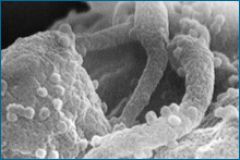Grade Level(s):
- 9-12
- 13-16
- General
Source:
- UC Museum of Paleontology
Resource type:
- Evo in the News article
Time: 20 minutes
Overview
HIV and malaria both constitute global health threats, respectively affecting more than 30 million and 200 million people worldwide. This news brief from October 2008 describes new research that reveals an unexpected evolutionary link between the two.

- [Evidence of evolution: Grades 9-12] Some traits of organisms are not adaptive.
- [Mechanisms of evolution: Grades 9-12] Evolution results from selection acting upon genetic variation within a population. (LS4.B)
- [Mechanisms of evolution: Grades 9-12] Evolution results from genetic drift acting upon genetic variation within a population.
- [Mechanisms of evolution: Grades 9-12] Mutations are random.
- [Mechanisms of evolution: Grades 9-12] Populations, not individuals, evolve.
- [Mechanisms of evolution: Grades 9-12] Over time, the proportion of individuals with advantageous characteristics may increase due to their likelihood of surviving and reproducing. (LS4.B, LS4.C)
- [Mechanisms of evolution: Grades 9-12] Depending on environmental conditions, inherited characteristics may be advantageous, neutral, or detrimental.
- [Nature of science: Grades 9-12] Scientific knowledge is open to question and revision as we come up with new ideas and discover new evidence. (P4, P6, NOS3)
- [Nature of science: Grades 9-12] Scientists can test ideas about events and processes long past, very distant, and not directly observable.
- [Studying evolution: Grades 9-12] As with other scientific disciplines, evolutionary biology has applications that factor into everyday life.
- Disciplinary Core Idea LS4.B: Natural Selection
- Disciplinary Core Idea LS4.C: Adaptation
- NOS Matrix understanding category 3. Scientific knowledge is open to revision in light of new evidence.
- Science and Engineering Practice 4. Analyzing and interpreting data
- Science and Engineering Practice 6. Constructing explanations and designing solutions
This article includes a set of discussion and extension questions for use in class. It also includes hints about related lessons that might be used in conjunction with this one. This example could be easily integrated into instruction on basic selection, particularly as a supplement to discussion of the classic sickle cell anemia example. Get more tips for using Evo in the News articles in your classroom.
